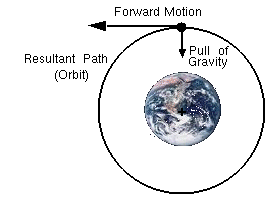How is it that the elliptical quality of the moon's orbit creates accelerated motion?
1 Answer
See below:
Explanation:
Let's start by talking about Newton's First Law of Motion:
An object at rest will stay at rest unless acted upon by an unbalanced force. An object in motion will stay in motion with the same speed and in the same direction unless acted upon by an unbalanced force.
http://teachertech.rice.edu/Participants/louviere/Newton/law1.html
So let's look at the Moon as it orbits around the Earth.
 pics-about-space.com
pics-about-space.com
So there's the Moon moving around the Earth (the black dot with the two arrows). Newton's First Law, if there was no other forces acting on the Moon, would follow the Forward Motion arrow - it would fly off happily, in a straight line at a constant speed, forever.
But it doesn't. Why is that?
Because there is another force acting on the Moon - which is the Pull of Gravity arrow. Earth's gravity, if there were no other forces acting on the Moon, would have it plunging down onto (and into) the Earth - resulting in the biggest collision the world has ever experienced.
Thankfully, the balance of the forces, the Moon's inertia and Earth's gravity, act on the Moon to keep it in orbit (one of my professors described it as "the Moon is continually falling towards the Earth and missing").
And so the interaction of the two forces creates accelerated movement - Earth's gravity constantly pulls on the Moon and that is the source of the acceleration (that constant change in direction).
So now to the Kepler portion of the question - it is true that orbits are slightly elliptical and not purely circular. In the case of the Moon, this ellipse is quite elongated compared to the orbit of the Earth revolving around the Sun. However, it is not the elliptical quality of the orbit that makes the orbiting motion accelerated motion.
https://www.ifa.hawaii.edu/~barnes/ASTR110L_S03/lunarorbit.html

